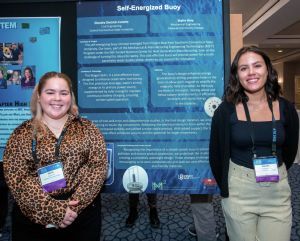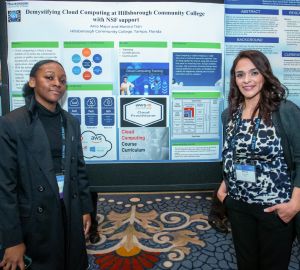How Advanced Technological Education (ATE) initiatives positively influence students’ entrée into advanced technology careers was evident at the student poster session at the 2023 ATE Principal Investigators’ Conference on October 25 in Washington, D.C. The annual conference is hosted by the American Association of Community Colleges with support from its ATE grant from the National Science Foundation (NSF).
In their own words on posters and in energetic response to questions posed by conference attendees who viewed the posters during the lively 90-minute session after the opening plenary, the students shared what they had learned as a result of the ATE-grant funded initiatives.
The posters created by 48 students and alumni documented a wide array of learning experiences, including classroom instruction, labs, internships, apprenticeships, undergraduate research projects, and competitions. Here are two of the outstanding projects featured at the poster session.
Team Develops Prototype of Self-Energizing Buoy for Sea Farms

Skylre Hine, a mechanical engineering major at Connecticut State Community College Gateway, was part of a four-person, all-female team that created a buoy that harnesses kinetic energy from water movement and solar energy to power a battery for monitoring equipment used by sea farms.
The other team members were from Connecticut State Community College Naugatuck Valley and Southern Connecticut State University. Central Connecticut State University became involved this fall when one of the team members transferred to it.
The prototype the team created with a 3D printer “did generate enough energy to power the equipment” when tested in a creek and river. There was not enough time during the three-month undergraduate research program for the team to meet the environmental standards for testing in Long Island Sound.
“We hope that this idea is able to continue even if it is not continuing through us because it is just so beneficial to the environment and really anything. There’s no downside to it. We spent $200 making it. There’s no chemicals. There’s not leakage.” Hine said.
The undergraduate research project is an initiative of the National Center for Next Generation Manufacturing, an ATE center hosted by the Connecticut College of Technology. The concept for the buoy began with Project Blue at Southern Connecticut State University and a request from an industry partner seeking new ways to power water quality probes used in aquaculture operations.
Students Help Project that Aims to Demystify Cloud Computing Careers

Ania Major and Monica Tran said they enjoy being among the first students taking cloud computing courses that Mubarak Banisakher, principal investigator of An Initiative of Closing the Cloud Computing Skills Gap, is developing at Hillsborough Community College in Florida.Banisakher is a computer science instructor at Hillsborough Community College.
Major changed her degree plan from network infrastructure to cloud computing after participating in the two-week boot camp the project offered during the summer. Major used what she learned during the camp to pass an Amazon Web Service certification exam.
“For me I loved the hands-on, the virtual labs,” she said of the camp where she, Tran, and other Hillsborough students learned and served as student assistants to the high school students who also participated in the boot camp.
“To be able to learn as we helped them was a great experience,” Major said.
The two women are now volunteer ambassadors for the program and have addressed multiple groups of urban teens about the cloud computing courses at the college and career opportunities.
Tran said, “Our goal is just to bring awareness to kids from middle school to high school, make it easy for them to get training at no cost with the help of NSF. We were able to bring in about 20 students this last semester.”
Major said when girls see and talk with her and Tran it persuades them that they too could go into cloud computing. She also thinks the flexibility of cloud computing careers and prospect of immediate jobs with AWS knowledge appeals to them, as it appeals to her.

 Subscribe
Subscribe


 See More ATE Impacts
See More ATE Impacts

Comments
There are no comments yet for this entry. Please Log In to post one.